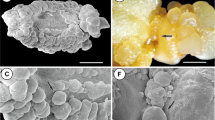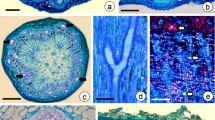Summary
In freeze-substituted sclerotia stained with aqueous toluidine blue O, metachromatic material was found throughout the cytoplasm in discrete granules. It was also distributed evenly throughout spherical and elongate protein bodies. This material stained at low pH and was extracted by cold acid, indicating that it was polyphosphate. Retention of metachromatic material was much greater than previously reported in chemically fixed, conventionally processed sclerotia. X-ray microanalysis of dry-cut, unstained sections of freeze-substituted sclerotia confirmed that phosphorus was distributed evenly throughout the protein bodies and was not localised in discrete granules but phosphorus levels in the cytoplasm were very low. It is concluded that polyphosphate is lost during conventional preparation procedures but retained in dry-cut, unstained sections of freeze-substituted material. However, when freeze-substituted sections were stained with toluidine blue O, water soluble polyphosphate was extracted and subsequently precipitated in the cytoplasm as polyphosphate granules. Therefore it is considered that polyphosphate granules are an artefact, and that protein bodies are the major site for storage of phosphorus in this fungus.
Similar content being viewed by others
Abbreviations
- STEM:
-
scanning transmission electron microscope
- ER:
-
endoplasmic reticulum
References
Ashford AE, Ling Lee M, Chilvers GA (1975) Polyphosphate in eucalypt mycorrhizas: a cytochemical demonstration. New Phytol 74: 447–453
Backhouse D, Stewart A (1987) Anatomy and histochemistry of resting and germinating sclerotia ofSclerotium cepivorum. Trans Br Mycol Soc 89: 561–567
Beever RE, Burns (1980) Phosphorus uptake, storage, and utilisation by fungi. Adv Bot Res 8: 127–219
Bloom W, Fawcett DW (1975) A textbook of histology, 10th edn. WB Saunders, Philadelphia
Bullock S, Ashford AE, Willetts HJ (1980 a) The structure and histochemistry ofSclerotinia minor Jagger II. Histochemistry of extracellular substances and cytoplasmic reserves. Protoplasma 104: 331–351
—, Willetts HJ, Ashford AE (1980 b) The structure and histochemistry ofSclerotinia minor Jagger I. Light and electron microscope studies on sclerotial development. Protoplasma 104: 315–331
Canny MJ, McCully ME (1986) Locating water-soluble vital stains in plant tissues by freeze-substitution and resin-embedding. J Microsc 142: 63–70
Dürr M, Urech K, Boller Th, Wiemken A, Schwenke J, Nagy M (1979) Sequestration of arginine by polyphosphate in vacuoles of yeast (Saccharomyces cerevisiae). Arch Microbiol 121: 169–175
Feder N, O'Brien TP (1968) Plant microtechnique: some principles and new methods. Amer J Bot 55: 123–142
Fleet GH, Phaff HJ (1981) Fungal glucans — structure and metabolism. In: Tanner W, Loewus FA (eds) Plant carbohydrates II. Springer, Berlin Heidelberg New York, pp 416–440 [Pirson A, Zimmermann MH (eds) Encyclopaedia of plant physiology, vol 13B]
Harold FM (1966) Inorganic polyphosphates in biology: structure, metabolism and function. Bacteriol Rev 30: 772–794
Hayat MA (1989) Principles and techniques of electron microscopy. Biological applications, 3rd edn. Macmillan, Hampshire
Horobin RW (1982) Histochemistry: an exploratory outline of histochemistry and biophysical staining. Fischer Butterworths, Stuttgart
Iversen T-H (1970) The morphology, occurrence and distribution of dilated cisternae of the endoplasmic reticulum in tissues of plants of theCruciferae. Protoplasma 71: 467–477
Kohn LM, Grenville DG (1989) Anatomy and histochemistry of stromatal anamorphs in the Sclerotiniaceae. Can J Bot 67: 371–393
Kulaev IS, Vagabov M (1983) Polyphosphate metabolism in microorganisms. Adv Microbial Physiol 24: 83–158
Miller JJ (1984) In vitro experiments concerning the state of polyphosphate in the yeast vacuole. Can J Microbiol 30: 236–246
Moore AEP, Ashford AE, Peterson RL (1991) Reserve substances inPaxillus involutus sclerotia. Determination by histochemistry and X-ray microanalysis. Protoplasma 163: 67–81
Nisikado Y, Hirata K (1937) Studies on the longevity of sclerotia of certain fungi under controlled environmental conditions. Ber Ohara Inst Landwirt Forsch 7: 535–547
O'Brien TP, McCully ME (1981) The study of plant structure: principles and selected methods. Termarcarphi, Melbourne
Orlovich DA, Ashford AE (1993) Polyphosphate granules are an artefact of specimen preparation in the ectomycorrhizal fungusPisolithus tinctorius. Protoplasma 173: 91–102
van Noorden S, Polak JM (1983) Immunocytochemistry today. Techniques and practice. In: Polak JM, Van Noorden S (eds) Immunocytochemistry: practical applications in pathology and biology. J Wright, Bristol, pp 11–42
Willetts HJ, Bullock S, Begg E, Matsumoto N (1990) The structure and histochemistry of sclerotia ofTyphula incarnata. Can J Bot 68: 2083–2091
Young N, Ashford AE (1992) Changes during development in the permeability of sclerotia ofSclerotinia minor to an apoplastic tracer. Protoplasma 167: 205–214
Author information
Authors and Affiliations
Rights and permissions
About this article
Cite this article
Young, N., Bullock, S., Orlovich, D.A. et al. Association of polyphosphate with protein in freeze-substituted sclerotia ofSclerotinia minor . Protoplasma 174, 134–141 (1993). https://doi.org/10.1007/BF01379045
Received:
Accepted:
Issue Date:
DOI: https://doi.org/10.1007/BF01379045




